
By Angelo Randaci, Earth’s Ally Horticulturist
Angelo’s passion for plants has led him to explore many areas of horticulture including research, grounds management, technical training, design and nursery management.
After many people left the farm for lives in the expanding cities, they grew lonely for their cherished countryside filled with beautiful flowers and luscious green foliage. To make up for the absence of vast gardens and parks, people began to revive the custom from the ancient Egyptians of bringing plants indoors to soothe the craving for the woods and fields.
The Victorian era of the 1800s saw the first revision of houseplants grown by the middle class used as a symbol of status. As a quintessential Victorian plant, the Parlor Palm was a favored adornment in drawing rooms of the 19th century. With the rise of the Art Deco era of the Roaring ‘20s, house plants were given high status as architectural ornamentation.
During the ‘60s, indoor houseplants became all the rage once again. It began slowly with the African violet craze. They were small, easy to grow, and did well under soft lighting. As fluorescent indoor grow light fixtures became more available, the houseplant trend expanded to include more and more varieties and plant specimens. Since it was easy to hang the newer fluorescent fixtures anywhere in the home. people were able to grow their cherished plants wherever they could. When the ‘70s rolled around, ferns and spider plants dominated the scene. They were beautifully displayed in attractive macrame hangers along with other trailing plants. As the ‘70s floated into the ‘80s and ‘90s, there was a rise in popularity for old-fashioned blooming plants like primroses and begonias that were popular during the Wardian case crazy of the late 1800s.
Related: Popular Vintage Houseplants
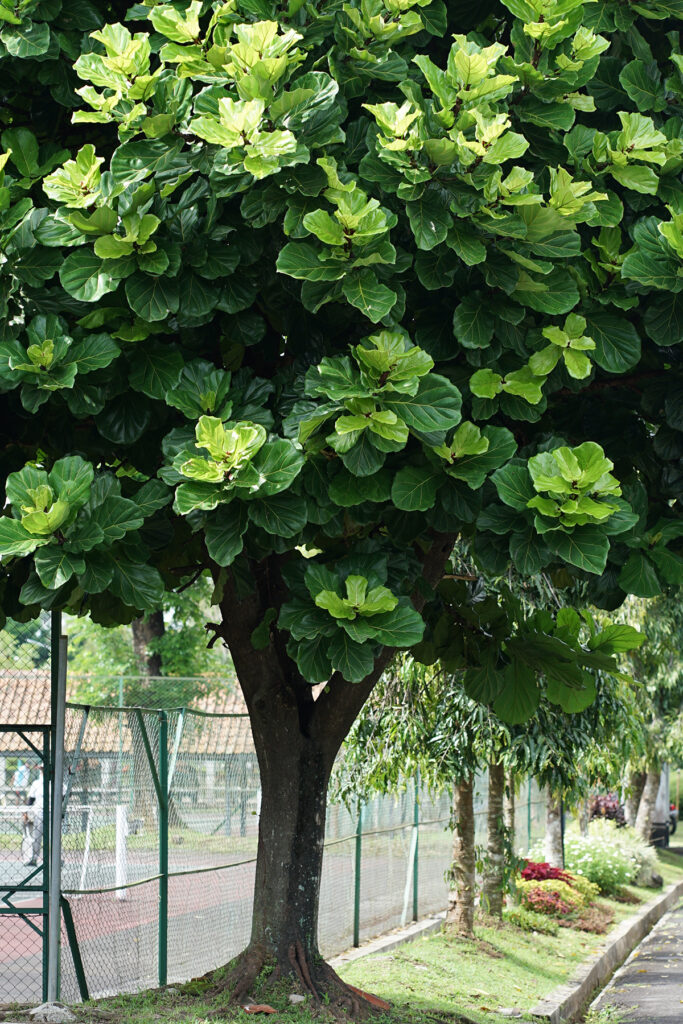
Ivies and hoyas became popular during the 2000s along with the ever-popular weeping Ficus (Ficus benjamina), but it wasn’t until around 2010 that fiddle leaf figs exploded onto the design scene. They began to be displayed in homes across the country. It was stated in The New York Times in 2016, “This decade belongs, undeniably, to the fiddle-leaf fig.” They are still one of the most popular houseplants today. By the mid-2000s, interior designers relished the trend toward plants with strong architectural lines accented by large bold leaves. Its sculptural shape and oversized leaves are a true standout in any room.
Ficus lyrata is native to western Africa where it can grow up to 40 to 50 feet tall. It is a popular ornamental tree in subtropical and tropical regions from USDA Hardiness Zones 9-11. While wild specimens grow in lowland rainforests where they receive bright indirect sunlight below the forest canopy, they can withstand full sun and a wide range of soil types as long as the soil is well drained. Typical temperatures within their range are 65-85°F with humidity of 77-88% year-round.
Fun Fact: Ficus lyrata requires pollination from a certain species of wasp to set viable seeds. This wasp, Agaon spatulatum, is the only species that will pollinate and lay eggs on this species of ficus. Different fig wasps are required to pollinate different species of figs. However, many figs sold in supermarkets for human consumption are self-pollinating.
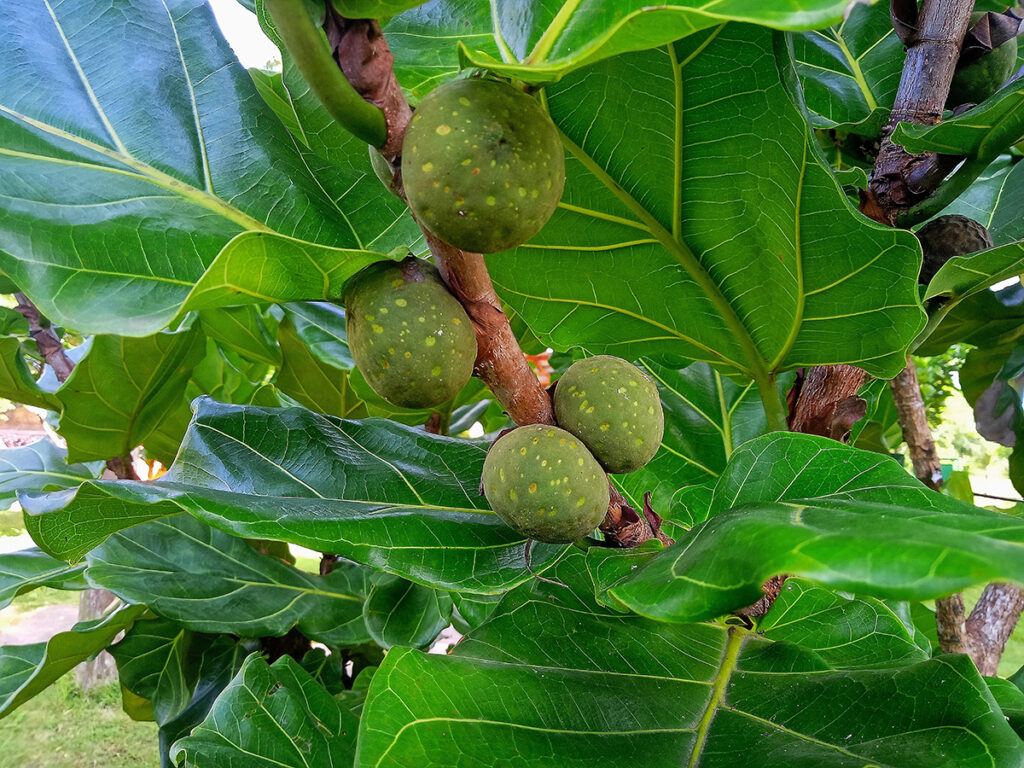
Choosing Your Fiddle Leaf Fig
Leaves should be shiny, should have a firm trunk, and show evidence of new growth. Trunks are fairly thin and delicate-looking compared to their large leaves. This is the natural growth habit. The habit can be either tall and thin without lower leaves, or bushy and full with a complete set of leaves from top to bottom of the trunk and that’s okay too. Lower leaves sometimes point downward naturally, especially the leaves on the lower trunk. Look for any signs of pests. Check the soil in the pot to see that it is not too dry or too wet. Stress symptoms may not become visible on the plant until you get it home. Buying from a reputable nursery that stands behind its plants will better ensure that you are purchasing a healthy plant that was grown responsibly.
Choose a Fiddle Leaf Fig to Fit Your Space
A standard Ficus lyrata can easily reach 6 feet or more indoors, but a more compact grower is available. Ficus lyrata ‘Bambino’ is a shorter version that will only grow 3-4 feet tall. A variegated Ficus is also available having beautiful cream and green tones. If your space requires a large specimen, purchasing a more mature tree–although more expensive–will be better than a smaller, less expensive plant that will take a few years to reach the desired size. One advantage of acquiring a smaller plant, however, is that it can better acclimate to the home environment as it matures.
Getting Your New Fiddle Leaf Fig Home
Avoid excessive heat or A/C blowing directly on your plant when transporting it in your vehicle. This can cause blemishes on the leaves. Sunburn on the leaves can also occur from harsh sun coming in through the windows.
Protect the leaves from tearing by making sure your plant is secure. If you have to lay the plant down, wrap the base of the trunk and pot with a blanket or towel, and be careful not to smash the leaves on the floor of your vehicle.
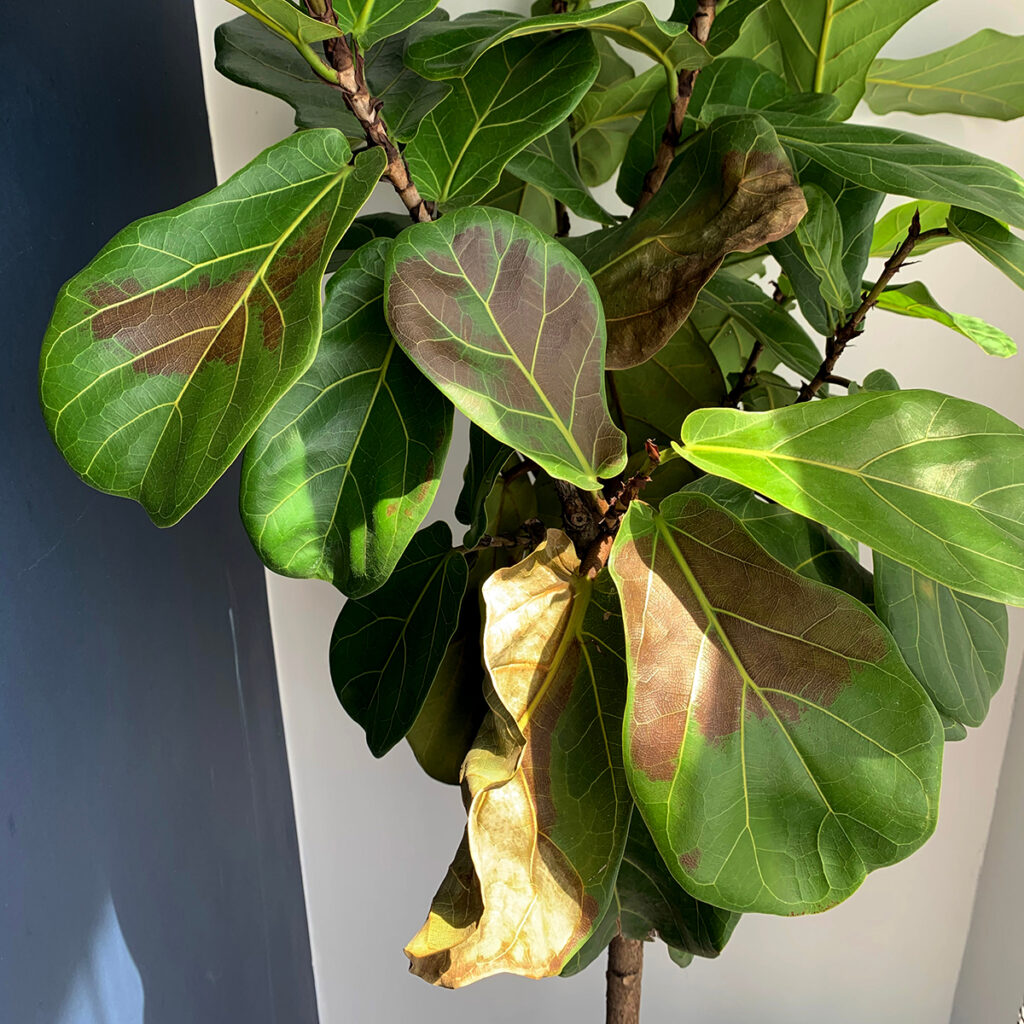
After Your Fiddle Leaf Fig is Home
Keep in mind your new Fiddle Leaf Fig was grown by professionals under ideal conditions. While they will grow in varying light levels from deep shade to full sun, they were grown in fairly low light to better survive interior landscapes. Placing them in full sun could burn the leaves.
The plant you bring home was likely grown under 70-80% shade before it was shipped to your favorite nursery. This equals 3,750- and 2,500-foot candles respectively. In the home, a bright indirect light will work well (this equals 1,000-2,000 foot candles).
Related: Styling Your Home With Indoor Plant Displays
You can achieve a bright indirect light by placing your plant in an east, west, or south-facing room by adjusting the distance from your light source. If you live in an area with long winters, consider adding supplemental lighting. A simple grow light setup will allow you to grow your fiddle leaf fig anywhere in your home.
Because Ficus trees react adversely to changes in their environment, it is common for them to wilt or drop their leaves from changes in temperature, humidity, and light as they get used to their new home. Sometimes brown spots can show up on leaves days later after a move due to physical trauma. Allow your plant to acclimatize because the new leaves that grow will adapt to their new living conditions. Provide bright indirect or direct morning sunlight daily. This is not a low-light plant and will grow very slowly and poorly if kept in low light.
Watering
Fiddle leaf figs are extremely susceptible to root rot. This happens when soil remains too wet or soggy. For this reason, underwatering is better than over-watering. It’s easier to save a plant that has been underwatered than one that was overwatered. It is best to use either room temp or warm filtered or rainwater as opposed to tap water to avoid damage from any harsh chemicals that can build up over time. Your tap water quality depends on where you live.
Always test your soil before watering. The common practice is to stick your finger into the first few inches of the soil and if it feels dry, it is time to water. In larger pots, however, do not depend on the finger method. Even though the top 2-3” feel dry, the lower half of the pot may have plenty of moisture. It is better to use a moisture meter pushed as far down as possible to get an accurate reading. Do not water until your meter reads on the dry side. Another method is to take a bamboo skewer or chopstick and put it in the soil. After 30 seconds or so remove it and check it. If it comes out dry, then you can water it.
When in doubt, do not water. How often to water depends on the environment of your home; factors of light, humidity, etc.
For plants in smaller pots, add water slowly around the stem and not the edges of the pot. The reason is that there may be air gaps between the soil and the edges of the pot and water will run straight to the saucer. Add water until you see it coming out of the drainage hole. Wait 15 minutes or so. If the water that drained into the saucer was absorbed by the soil, add a little more water and wait again. When water remains in the saucer, it means your soil is properly saturated and you can empty the excess water. This is a good watering method for all your houseplants in smaller pots.
Repotting
Unless your plant is completely rootbound, it’s best not to repot a newly-purchased plant for a month or two. Remember that these plants do not like change. Gently lift the plant out of its container and check the roots. A plant is rootbound when there is no soil left in the container and all you have is a mass of roots. If it is not rootbound, allow it to become acclimatized to its new home.
Your plant, however, will eventually need repotting with fresh soil for it to continue its growth. Repot anytime your plant is actively growing. Choose a container with drainage holes that is only a few inches larger than its original pot. For example, if your plant is currently in a 6-inch diameter pot, move it up to an 8-inch diameter pot. The type of pot you choose makes a difference in how quickly your soil dries. Unglazed terra cotta pots are porous and will dry out more quickly than other pot types.
Choose a potting soil that drains quickly to keep its roots from standing water. Potting mixes made specifically for Fiddle leaf figs are available, but a well-draining potting mix consisting of 3 parts potting mix to 1 part perlite is a good option. I prefer the large diameter #3 perlite which allows for better drainage and air pore space for the roots.
Fertilizing
In their natural environment, fiddle leaf figs receive adequate nutrients from the organic matter in the soil. This provides them with a steady supply of nutrients needed for healthy growth. Our potted plants are totally dependent on what nutrients are contained in the potting mix. They can use up the available nutrients very quickly in this situation. Fertilize with a 3-1-2 NPK ratio fertilizer. Wait a few weeks before fertilizing newly purchased plants. Fertilize every 2-4 weeks during spring and summer following instructions on your product label.
Pruning
You will have an opportunity to shape the desired form of your matured plant with pruning techniques. The tree form (called a standard) has a single trunk and may have the bottom leaves removed. If you want a bushy plant or need to control the size, you can achieve this by pruning. Make your cut between 2 nodes. Two side branches will grow just below your cut.
Your Ficus will secrete a milky white sap from your pruning cuts. You may want to wear gloves because the sap can cause skin irritation. Sap can also drip onto the floor and furniture so make sure you have these areas protected.
Tip: When white sap drips from pruning cuts, rather than letting the sap drip, wrap a wet cloth or paper towel around the wound and leave it on until the cloth is dry.
Fiddle Leaf Fig Problems, Pests, and Diseases
Diseases
The most common disease with fiddle leaf figs is root rot. This fungal infection is caused by your plant receiving too much water along with poor drainage. This problem is worse if you have your plant in too little light. Symptoms of root rot include dark brown or black spots spreading throughout the leaf or at the base of the leaf. Leaf drop may also occur.
To treat root rot,
- Remove the plant from the container and examine the roots.
- Cut off any blackened, smelly, or mushy, decomposed roots. Sterilize your tools.
- Spread out and pull apart any matted roots. Wash root ball to remove any infected soil remaining on the roots.
- Treat the entire plant, including the roots, with Earth’s Ally Disease Control. Spray to runoff. Repeat treatment in 4 hours, then every 3 days as necessary.
- Repot into a very well-draining soil. Soil made for succulents will work well if you tend to overwater your plants.
- Water thoroughly.
- Use a moisture meter to tell you when to water again. This is better than sticking your fingers into the soil. While the top few inches appear dry, the roots further down may be moist or even wet. Water again when your meter reads dry.
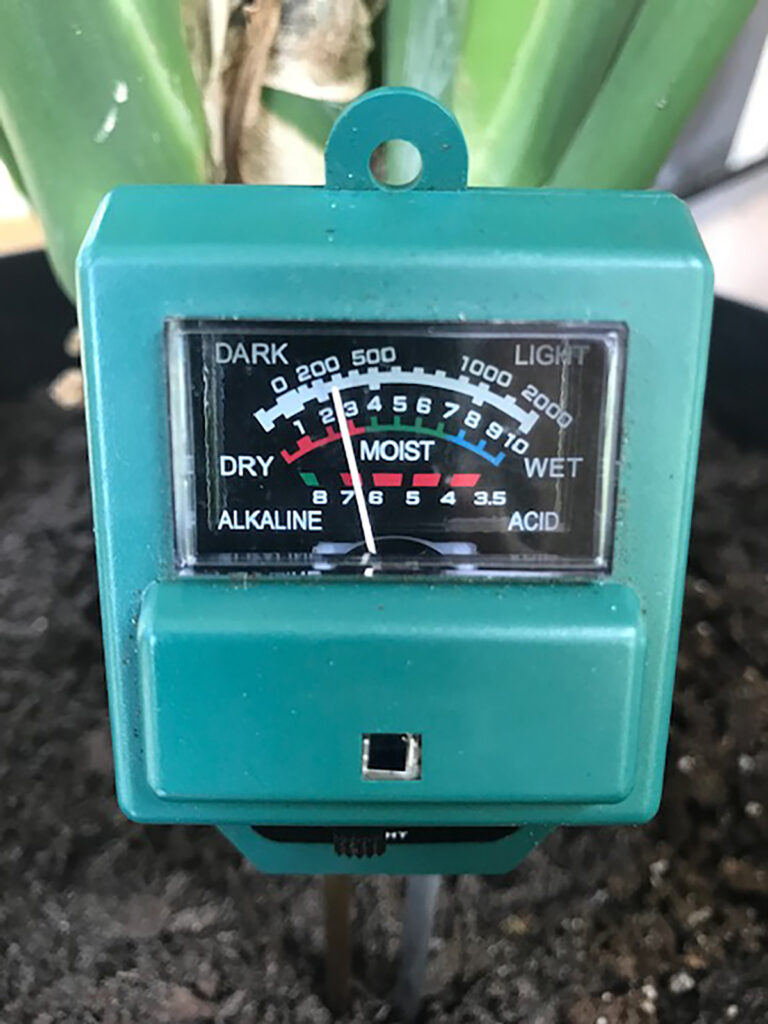
Bacterial infection
Symptoms of bacterial infection are lighter brown spots that are either tan or dark brown. If you ruled out root rot by checking the roots, you may have a bacterial infection. Remove any diseased debris in the container. Remove infested plant parts and avoid getting water on the leaves. Spray both upper and lower leaves with Earth’s Ally Disease Control, following the label instructions.
Cultural Issues
Other problems can somewhat mimic bacterial and fungal infections. Leaves can acquire brown spots from leaves that have dried out from too much heat and low humidity. Spots start at the edge of the leaf and spread inward. The spots are usually a light tan color.
Underwatering will also lead to browning of leaves that droop and look crispy.
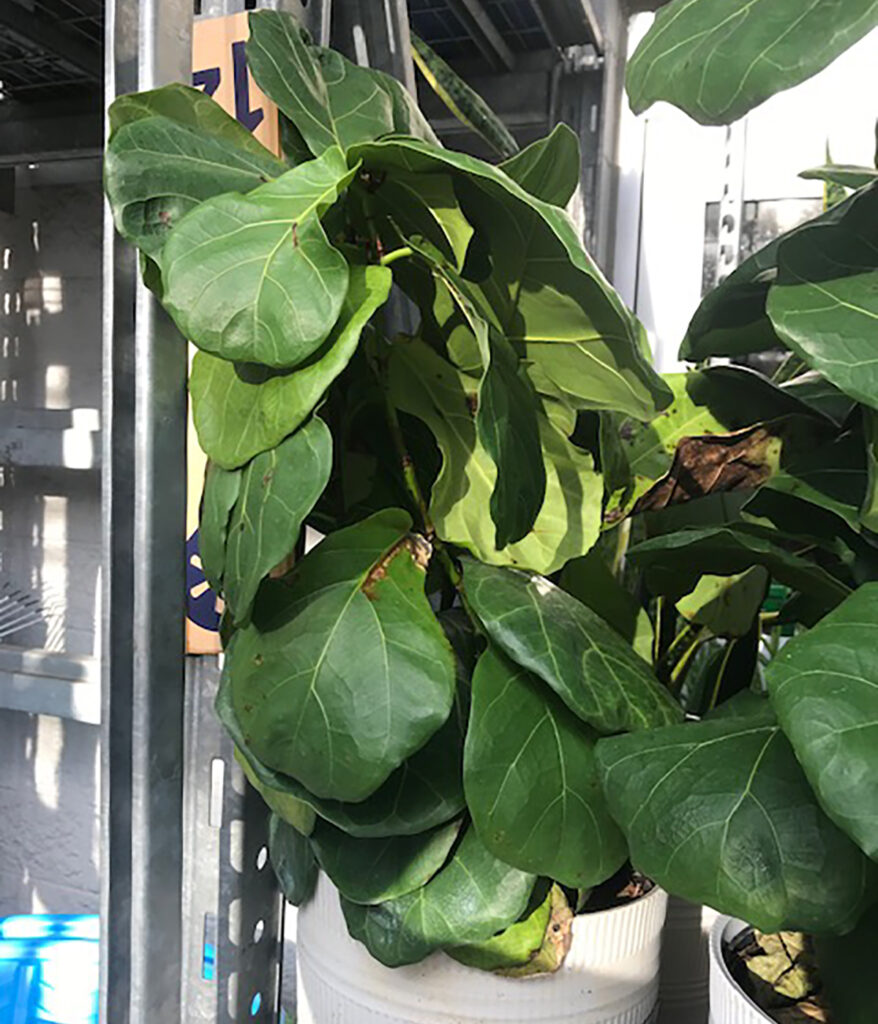
Plants receiving too much sunlight without being acclimated to full sun conditions may show brown spots or red and yellow coloring on the tops of the leaves.
Dropping lower leaves
It is natural for fiddle leaf figs to drop lower leaves as they grow taller and mature. Lower leaves often receive less light than leaves further up the plant. This may cause the shedding of lower leaves.
Edema
Edema appears as tiny brownish-red spots on new growth and occurs when your plant’s roots absorb more water than the leaves can consume or transpire. Pressure builds until the cells in the leaves burst. The spots will not go away but will be less noticeable as the leaves mature.
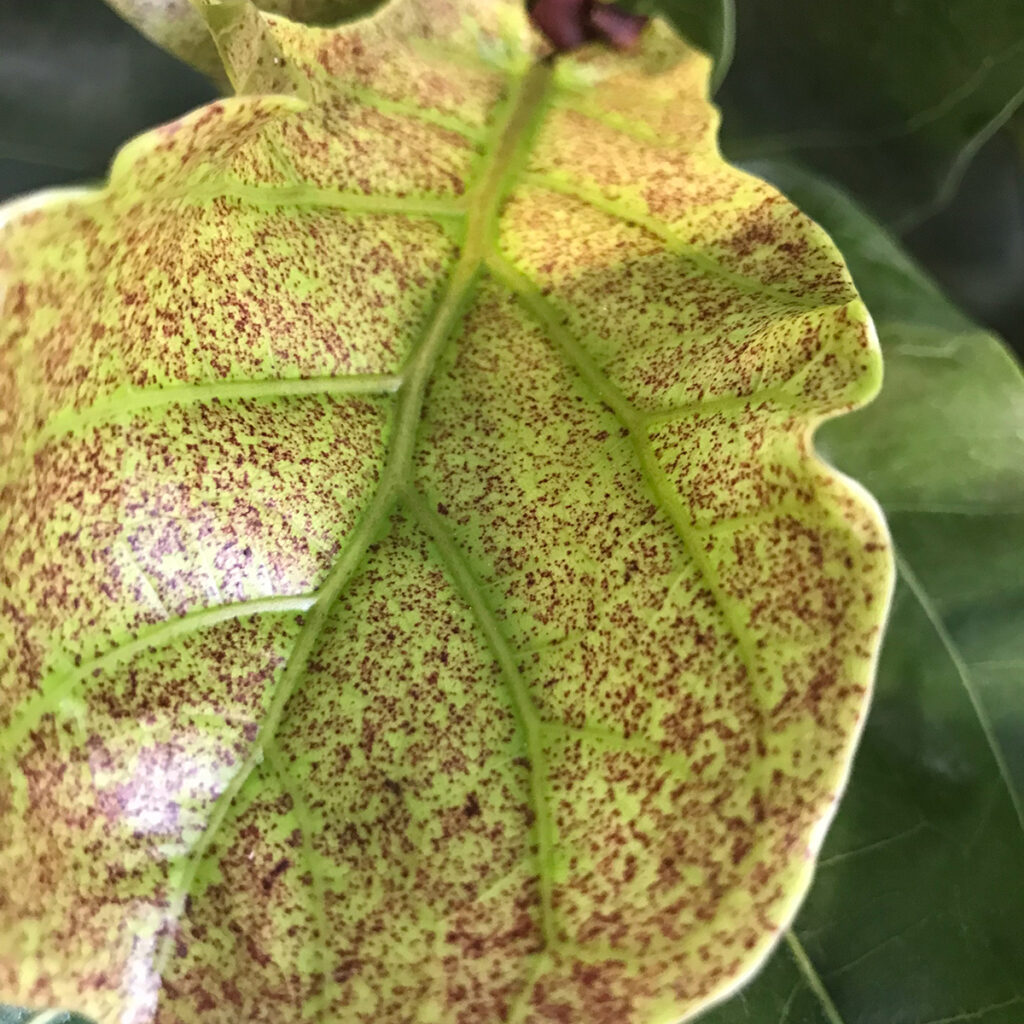
Damage from bruises
Brown spots may occur from bruising of the large leaves during transport. Brown spots may become evident a week or so after the plant has been moved. Bruises look like either cracks or tears at random on the leaf.
Insect Pests
The most common insect pests are spider mites, scales, mealybugs, aphids, and thrips. Check your plant often for any of these pests and treat them immediately with Earth’s Ally Insect Control. Follow the recommendations on the label.
We’d love to hear how Earth’s Ally Insect Control is helping you care for your houseplants! Share your experience and stay connected with the #EarthsAlly community on Facebook, Instagram and Twitter for access to our latest blog posts, giveaways and exclusive promotions.
